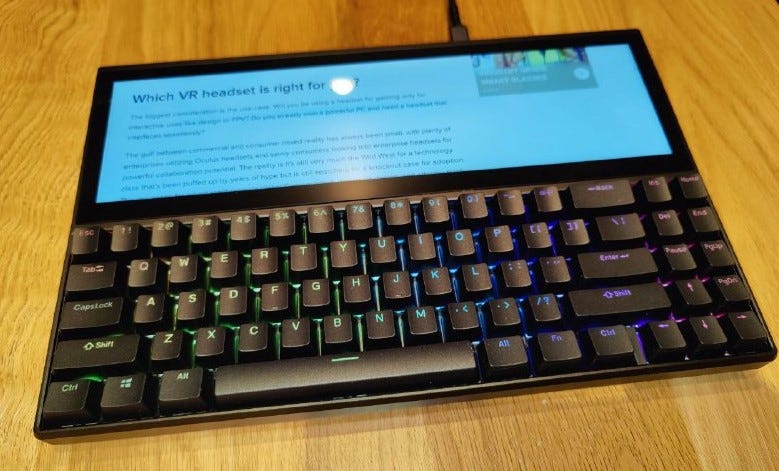Ficihp Multifunctional Keyboard offers the second screen of your cyberdeck dreams

Ficihp K2 Multifunctional Keyboard
When I wrote about the ASUS Zenbook Pro Duo late last year, I mentioned the
Ficihp Multifunctional Keyboard
, which takes the functionality of that laptop's lower deck — the combination of a keyboard and wide-but-short (32:9 aspect ratio) 12.6″ touchscreen — and makes it an accessory to any USB-C equipped phone, tablet, or 2-in-1s (as well as traditional clamshells if you don't mind having two keyboards taking up space).
With its laptop-like weight and thickness, ample footprint and lack of a battery, the product makes no nod to portability like the folding keyboards in my last column. It even hosts two USB-A connectors. That said, it can be used with smartphones for a more desktop-like experience, particularly if they host a windowing environment like Samsung's DeX. In this sense, the Ficihp acts like the “laptop shell” devices I wrote about in early 2020, albeit in a modern update to the cyberdeck-like form of the pioneering TRS-80 Model 100.
While it's unlikely that the designers of the USB-C standard anticipated the likes of the Ficihp, the device is a perfect match for the versatile connector. Attach it to a PC, Mac or Chromebook and, assuming your cable supports video functionality, the keyboard and display activate. After that, the experience can offer many of the advantages of the
Zenbook Duo's
second display, providing some of the flexibility of a second display without taking up the horizontal desk space that one requires. However, since the Ficihp lacks a second USB-C connector, it can't be daisy-chained the way many portable monitors can, and thus requires using a dedicated USB-C connector on the host device versus one that could do double duty of video out and power in as many portable monitors allow.
Unlike the Zenbook Duo's integrated second display, you can move the Ficihp keyboard around for more placement flexibility. On the other hand, the Fichip's 1920×515 display can't match the brightness, contrast, or resolution of ASUS's stunning OLED display. The Ficihp also can't take advantage of the display utilities that ASUS makes available on its notebook, which include instantly blanking or turning off the second display if it's not needed or distracting. The Zenbook Duo also allows the second display to tilt forward at a greater angle than the Fichip does, even with the latter's riser feet. While this isn't much of a problem if you're using the Fichip's screen for occasional reference or palettes, a screen hinge would go a long way toward improving usage comfort.
During its crowdfunding campaign, Ficihp offered both scissor-switch (K1) and mechanical versions (K2) of the keyboard. While both versions provide the standard gaming keyboard LED light show displays, the K2, which uses Gateron switches, is even larger than the substantial K1, and accommodates a full keypad as well as replaceable keycaps. Despite this, it's slightly less expensive and was the only version in stock at the company's website as of this writing.
Continuing the experimentation with the 32:9 aspect ratio displays, Lukos recently launched a standalone 4K touchscreen available through Indiegogo InDemand after raising almost $200,000 on Kickstarter. It features an adjustable tilt angle and cover that doubles as a stand. However, its low profile is disrupted by top-mounted connectors and its $419 promotional price could net a full-height portable 4K display and costs significantly more than the Ficihp keyboard combo (which has a lower resolution). If one were willing to piece together the processing (perhaps a PC stick) and input options, it could be the ultimate screen for coach class airline seats.

